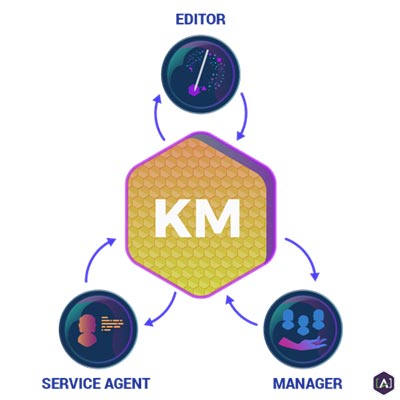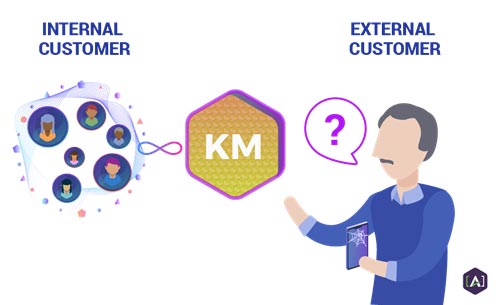The Treasury hosts many resources examining the various aspects of content, from strategy to operations, but it's important to also inspect the knowledge management aspect as well. In this series, we explore the impact intelligently managing our content has and the benefits of knowledge freely flowing throughout the enterprise.
What is Knowledge Management?
The Knowledge Management function focuses on the “what” and “how” of a company's products and services. Enterprise knowledge investments typically promote an organization’s “reason for being” – the organization’s products, services, and added value to the marketplace.
The crowd-sourced definition from
Wikipedia states it is “the process of creating, sharing, using, and managing the knowledge and information of an organization. It refers to a multidisciplinary approach to achieve organizational objectives by making the best use of knowledge.”
Today, many large organizations dedicate resources to their Knowledge Management initiatives. These efforts are usually part of biz strategy, IT, or HR depts. Knowledge Management typically focuses on objectives like competitive advantage, innovation, continuous learning, or improved performance. Knowledge Management is a key enabler of organizational learning.
In our white paper, “
Creating Content-as-a-Service through smart Knowledge Management practices,” we discuss why Knowledge Management’s biggest value is still to be fully realized. The combined impact of engineering content sets, graph technology, and Content-as-a-Service architectures are setting the course to innovate enterprise Knowledge Management. Full access to effective knowledge will remain impaired until content orchestration models and methodology move beyond the traditional siloed workflows.
Knowledge Management in Action
Leading organizations realize the impact of orchestrating intelligent customer experiences and investing in these practices and roles. Many company functions integrate with Knowledge Management systems, including customer support, training, onboarding, documentation, and the service desk. Depending on the organization, Knowledge Management systems often intersect far beyond traditional areas into marketing, public relations, strategy, market research, and thought leadership functions.
Within a customer service team, a Knowledge Management solution provides specific benefits to different stakeholders:
- Service Agent: find information via a single-source of information; provide guided chats for easy and consistent service; work with built-in e-learning
- Editor: craft custom workflows; create custom-built approval processes; create guided scripts and chats; address complex topics with the ease of a Powerpoint flowchart
- Manager: ensure consistent service from all agents; centrally manage scripts and guides; faster onboarding for new agents; generate custom reports

Ultimately, a Knowledge Management System would be any type of IT system that stores and retrieves knowledge to improve understanding, collaboration, and process alignment. The knowledge itself already exists within your organization: it's in your documentation—your manuals, guidelines, lists, databases, memos, and files. It's also in the minds of your team members – this is the expertise that enhances your business.
Knowledge is power, and when properly harnessed, it fuels a successful company.
Importance of Knowledge Management
Implementation of Knowledge Management within your organization will increase productivity and satisfaction across departments in several areas:
- Speed up Access to Information: manual processes like internal e-mail requests and searches within dedicated servers are eliminated. With critical knowledge (tagged with rich metadata) resident in a CaaS cloud, information access becomes second nature to team members.
- Quicker Content Research: Knowledge Management can capture critical, internal business intelligence. Failures as well as successes need to be considered in product design and other decision-driven efforts. Unimpeded access to your product or marketing campaign history can lead to swifter decisions, avoiding reliving mistakes from the past.
- Improve the Efficiency of Business Units: the swifter exchange of internal information within business units, (for instance between sales and marketing), progressively leads to measurable efficiency. Swifter time-to-market and reduced employee-burnout result from a painless form of free-flowing knowledge and information.
- Promote Innovation and Information Sharing: a well-designed Knowledge Management system can make it second nature for team members to capture insights, lessons learned, and new solutions. This eliminates the old “I don’t have time to document this” syndrome that occurred at the end of long and challenging projects. It also leads to internal business information capture from team members who may not be with you the next time a project or product is updated.
- Increase Customer Satisfaction: because outward-facing Knowledge Management makes the most commonly sought questions easily answered directly to customer queries, your organization will experience customer call center deflection. This can be achieved through automated systems that serve up information from the Knowledge Management System (KMS) at the appropriate moment. The reduction in human-to-human touchpoints involving salaried staff leads to exponential cost savings.
Direct benefits from a CaaS-based KMS
[A] helps to
engineer solutions for clients to easily structure their content to identify structure and semantics within a piece of content. Semantic systems can integrate with tools and content management systems, even via Word templates, to empower authors to inject semantics directly into the content. Thus, they can apply this externally to the content-based IDs or the component content management system (CCMS) and can add semantics to topics, even using managed word lists. With the addition of metadata, controlled word lists or controlled vocabularies can be applied more efficiently.
This new method of content enrichment concurrent with authoring makes the content more findable within the Knowledge Management System itself. So new content is findable for other authors, helping to avoid content duplication.
Tangible benefits in practice -- Knowledge Management makes knowledge more available both internally and externally:
- Internal: An effective CaaS-based Knowledge Management solution can save time for internal team members and help break down silos across many workgroups, markets, and businesses. Knowledge Management can be used for cross-training programs, including shadowing, mentoring, and other training programs which enable employees to capture business information by viewing how other team members work. Information that used to be disseminated via traditional document management systems can be more effectively accessed via Knowledge Management. Information captured in Knowledge Management can even potentially be distributed via chatbots.
- External: Because the solution described here makes knowledge and content more findable, external consumers can now find knowledge without assistance from customer service.

Knowledge Management is no longer only the province of human resources or internal training departments. The wider spread of team members accessing critical internal knowledge has caused a move away from older, “containers.” Since the shift in how content flows has already happened, the migration away from single-silo Knowledge Management applications is a foregone conclusion. Now organizations are rapidly navigating towards an AI-supported and extended organizational “knowledge sphere”.
Shifting knowledge capital into structured, semantically-rich forms, and connecting those assets to machine learning and other AI enhancements are essential to survive in this new world.
The future enterprise is being built with modular content. Innovative teams are enriching critical knowledge assets into structured, semantic content forms, then connecting these modular components into Content-as-a-Service (CaaS). These changes in enterprise knowledge and content management are here now and rapidly accelerating. Leading organizations realize the impact of orchestrating intelligent customer experiences and are investing in these practices and roles. The results are pouring in and the trend is clear. In our next article, we cover these trends.
Contact Us for a Free Consultation.